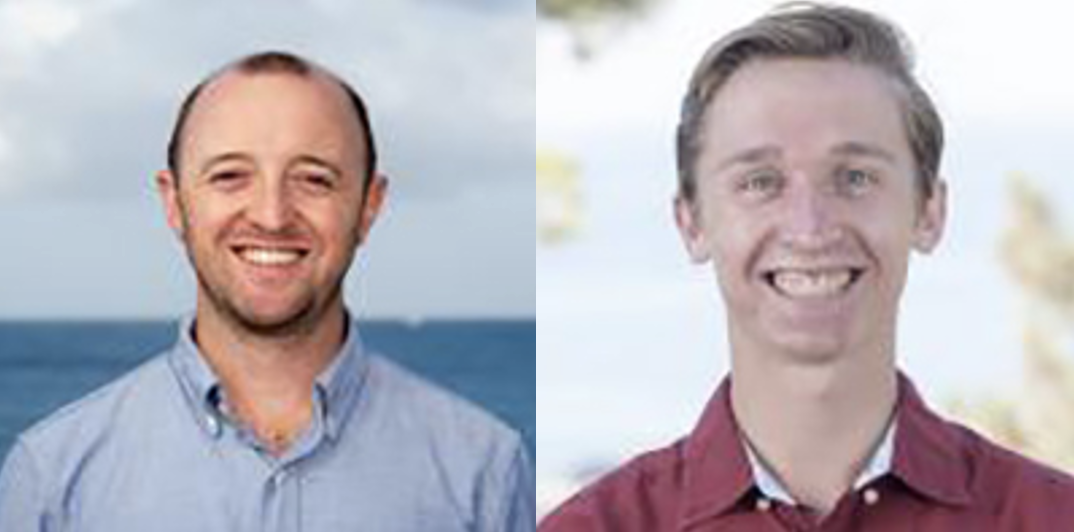
Billy Jenkins & Matthew Kehrli
Title: Estimating geoacoustic parameters using Bayesian optimization with a Gaussian process surrogate model
Abstract: Geoacoustic model optimization and inversion are computationally expensive endeavors. Recent work proposes replacing exhaustive or Monte Carlo sampling of parameter space with a Bayesian optimization approach that uses a Gaussian process as a surrogate model of the objective function. In this work, the objective function is defined as a Bartlett processor whose output measures the match between a received and replica pressure field on a vertical line array. The replica field is obtained using a normal mode propagation model whose geoacoustic parameters are selected from the parameter search space. The surrogate model represents the posterior on the objective function and is updated with each model evaluation. Optimization is performed with sequential model evaluations, with an acquisition function guiding the next point in parameter space to be evaluated. Initial results for the simple, 2-D localization problem indicate that Bayesian optimization using a Gaussian process surrogate model converges rapidly on an approximated optimal solution.
Bio: Billy Jenkins is a PhD candidate and a 2018 National Defense Science & Engineering Graduate Fellow working with Peter Gerstoft on the application of machine learning techniques in acoustic and seismic signal processing. He previously served in the US Navy as a submarine warfare officer on board the attack submarine USS Providence, and as a flag aide in Yokosuka, Japan. He remains active in the Navy Reserve supporting undersea warfare operations, and in 2019 deployed to Kabul, Afghanistan with NATO’s Operation Resolute Support. Billy graduated from the US Naval Academy in 2009 with his bachelor’s degree in oceanography and a minor in German, and from the Naval Postgraduate School in 2010 with his master’s degree in engineering acoustics. Contact: wjenkins@ucsd.edu
Title: Estimation of CDOM and non-algal particulate absorption coefficients in the ultraviolet by extrapolation of measurements from the visible spectral region
Abstract: The upcoming NASA PACE (Plankton, Aerosol, Cloud, ocean Ecosystem) mission will provide high-spectral resolution radiometric measurements from space including the extension of spectral coverage to the ultraviolet (UV). Existing remote-sensing reflectance algorithms that derive the total absorption coefficient, a, and associated absorption partitioning models that partition a into phytoplankton, aph, non-algal particulate, ad, and chromophoric dissolved organic matter (CDOM), ag, components are typically developed and validated in the visible (VIS). Given recent advances in remote-sensing reflectance and absorption partitioning models for the VIS, it is important to determine whether these absorption retrievals can be extrapolated to the near-UV range (350–400 nm) with satisfactory accuracy. We assembled a large quality-controlled dataset of constituent absorption coefficients measured from the UV to near-infrared at many locations across various ocean basins, and evaluated several extrapolation methods by examining different sections of the VIS as a basis for extrapolation, different extrapolation functions, and different spectral resolutions of data. As a result of these analyses, we formulated an optimal extrapolation method from measurements in the blue to the near-UV range. This method provides very good agreement between the extrapolated (modeled) and measured data in the near-UV range for the ag, ad, and adg (ag + ad) coefficients when the data in the blue have 1 to 5 nm spectral resolution. The median absolute percent difference between modeled and measured values is typically < 5% at all near-UV wavelengths for the three absorption coefficients, and the median ratio is very close to 1 indicating a negligible aggregate bias for the field dataset used in this evaluation. These promising results indicate a need for integrating the extrapolation method with models operating in the VIS and further testing of such integrated approaches.
Bio: Matthew Kehrli is a 3rd-year Ph.D. student working with Dariusz Stramski in the Ocean Optics Research Laboratory primarily studying ocean color inversion modeling techniques. He received his bachelor’s degree in physics with a minor in astronomy from California Polytechnic State University, San Luis Obispo, and received his master’s degree in oceanography from the University of California San Diego. Contact: mdkehrli@ucsd.edu




